In October 2023, Ernest Smith completed a bucket list 20-day loop of the Chesapeake Bay in his 17-foot Boston Whaler Montauk. He shares with us some of the decisions behind his journey, along with favorite moments, a few rough patches, and advice for fellow would-be adventurers who are dreaming of a similar journey.
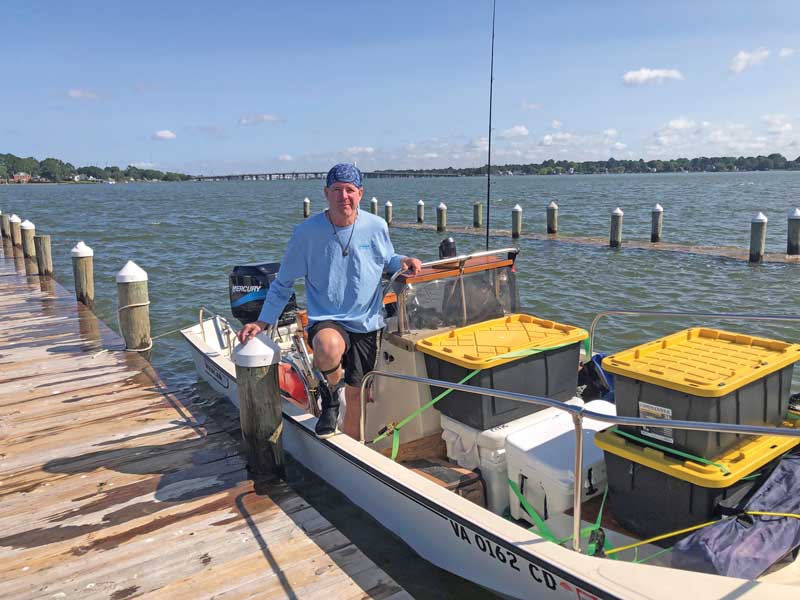
Could you describe your boat for us?
I have a 17-foot 1984 Boston Whaler Montauk with a 2003 90-hp Mercury two stroke. I bought the boat about five years ago and refurbished it adding a GPS, VHF, Garmin Echomap 106, a battery charger, a 120V inverter, and USB outlets among other things for the trip. I have been a lifelong Boston Whaler admirer, and I have owned several over the years. I chose the boat because of its ability to handle rough water and ease of operation. The most important reason is because I didn’t want to do the trip with any other type of boat—an old school Boston Whaler.
The Boston Whaler brand has just stuck with me; I’ve loved it since I was a kid. My neighbor had a 13-foot Super Sport. When I was going to do this trip, it was a no brainer—take the Whaler! If you’re a Boston Whaler fan, you’re a Boston Whaler fan for life.
How long had you been planning the trip?
I had been planning my trip on and off (a lot of daydreaming too!) for the better part of a year and knew I had to fulfill this lifelong dream. I’m retired, having spent 26 years as a Virginia State Trooper, and I knew I couldn’t do this trip until I retired.
I wanted a fair amount of uncertainty (to a degree) to see how I would handle adversity along the way. I would choose an area I wanted to end my day in and then choose a place to camp I had scoped out on Google. I have been in many parts of the Bay, mostly in the lower portion in the Hampton Roads area and parts near Annapolis, MD.
The route I planned was to navigate from Mile Marker 1 (of the ICW in Portsmouth, VA) and travel up the west side of the Bay to the Susquehanna River (headwaters of the Bay) and then back down the east side all the way to the Chesapeake Bay Bridge-Tunnel. The trip was originally planned for 30 days, however, family issues cut the trip to 20 days. I would usually travel about 25-35 miles a day while trying to end around 4 p.m. to locate a good campsite. Having never done anything like this before, I was relying on Google Maps to locate places I could camp. I also stayed with friends a few times and there were two occasions when I had to stay in a hotel (while waiting out a storm).
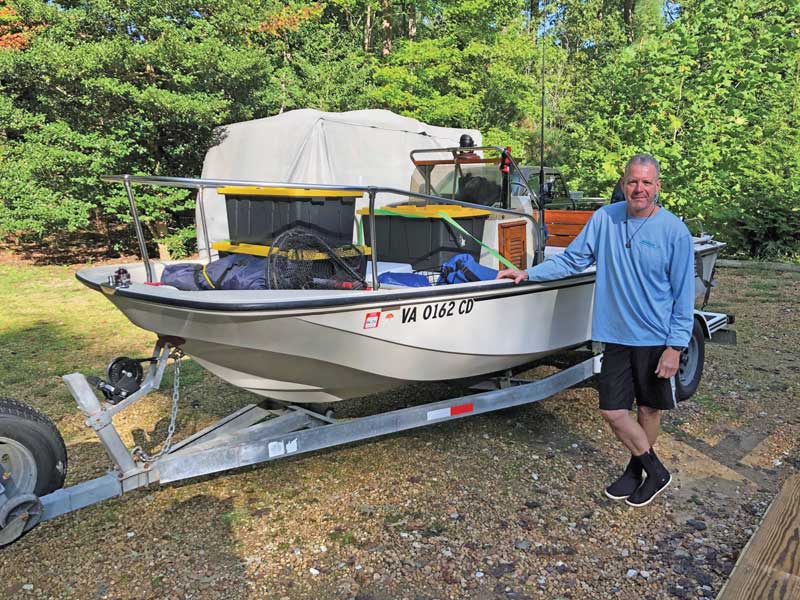
How did your boat fare on this journey? And did you keep track of general costs?
My boat did very well in handling heavy seas up until the last day. My center console came loose, and I had to secure it with rachet straps (the screws holding it down came loose). I did unexpectedly well on fuel considering all the gear I brought, burning an average of about 15 gallons a day. I spent about $600 on fuel and about the same for other expenses.
Do you have any "lessons learned" you would like to share with fellow boaters?
I learned I could have planned my food consumption a little better as I took way too much. Most importantly I learned how beautiful and big the Bay is. I had never spent this much time on the Bay and doing so gave me a much broader understanding of the issues facing it and the natural beauty we need to protect.
Did you have a favorite place along the journey?
Calvert Cliffs and Watts Island. The Cliffs offered an insight into the history of the Bay and Watts Island is disappearing, so I was fortunate to see it before it disappeared as so many places in the Bay have.
What advice would you give to someone who was thinking about undertaking a similar journey?
I would make sure you have a plan A, then a plan B, and for sure a plan C. Make sure friends/family members know what your plans are every day. Go through your gear and then go over it again. This helped me to be confident, knowing that I could do this. Being out on open water with no one around has its inherent dangers and you need to have a plan every step of the way if things don’t go as planned.
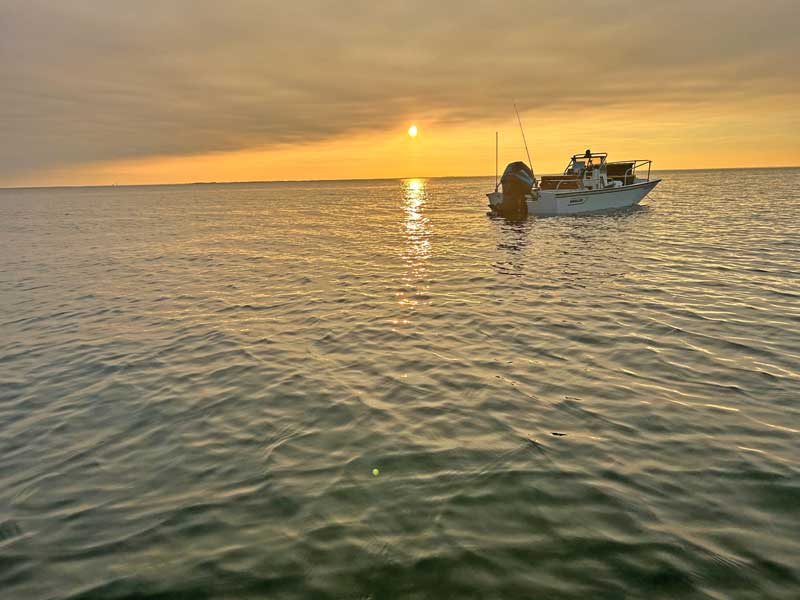
What made you choose October?
Basically, it was the weather. I didn’t want to go out in the middle of summer with the heat and humidity because I would be camping in a tent. I wanted a timeframe where the weather window would be ideal. It would be hurricane season, but you can plan for that, and I could have had someone come get me if needed. I did have some rough days (even with the advanced planning).
One day in particular, the winds were coming out of the northwest, and I was on the east side of the Bay. The wind was blowing about 20-25 miles an hour and I had loaded up for 30 days, so my boat was very heavy. While trying to cross from the mouth of the York River, all that water was building up across the Bay. It was a little hairy. I had a few worries that I might have to turn around, but I was so committed to heading out and starting on the first that I muscled through it.
After that the weather was really nice, up until I got up to the Annapolis area. There were a few showers but no wind, and the last two days were relatively rough. Outside of that there were a lot of calm days that were absolutely gorgeous.
Any difficulties with camping?
As it came closer to the trip, I started outfitting the boat the way I wanted it, knowing I probably wouldn’t be able to stay on the boat. My biggest challenge was finding a place to camp, especially on the western side, that wasn’t military and had a beach that would allow camping.
I researched on Google, because I didn’t really know anyone else who had done a trip like this. Most of the time it worked, but there were a few times where I threw my hands up and said, ‘there’s just no place to camp.’
I would go to look at at least two or three campsites and then try to find one that worked best. I would end the day at 4 p.m., set up the boat, and cook dinner. One of my big things was that I wanted to see the sunset. I had to make it to camp before sunset.
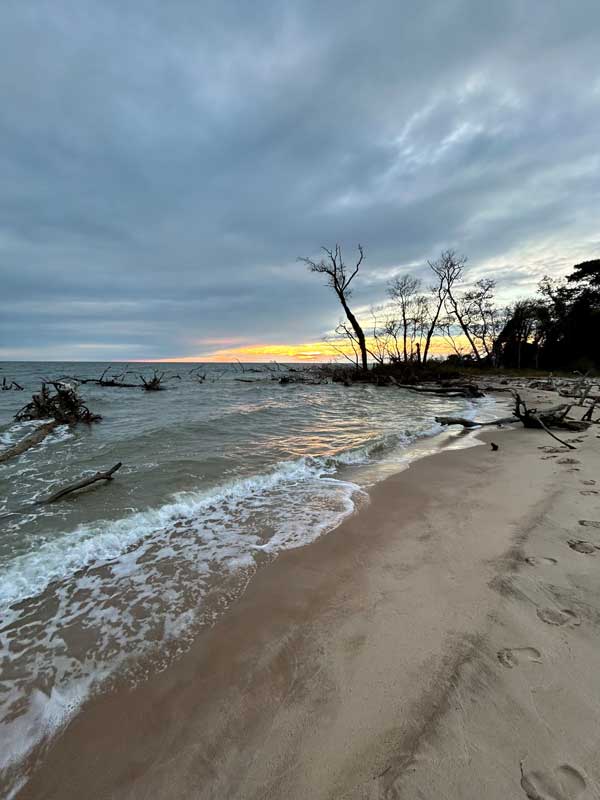
What about fuel and cell service?
I probably should have planned my meals better because I brought too much food and too much fuel. My boat got better fuel mileage than I expected. I was able to find gas pretty readily, but ahead of time I wasn’t sure if some places post Labor Day would be closed.
I didn’t want to run out of gas and get stuck anywhere. Surprisingly I had cell service for most of the trip (it was a little weak on the eastern side of Maryland; lots of wildlife refuges). I shared my location with six different people on my iPhone. They could just look me up. The thing that kind of surprised me was that when I was younger you could file a float plan with the Coast Guard, but now they say to just stay in touch with friends/family.
What were some highlights of your trip? Funny moments?
I had never done this before, but I shot the whole adventure on my GoPro. I’m a grandfather, so eventually I’d like my grandkids to see it. I wasn’t sure if I’d ever be able to do it again; it was a lifelong dream. When I was a kid, I mowed grass until I could afford to buy a Jon boat (I was maybe 10 or 11). After school I would burn three gallons one way exploring and have three gallons left to get home. That was real fun for when I was a kid, and really solidified my love of the water, my love of the Bay.
I timed the trip perfectly to make it to the Annapolis Powerboat Show.
I had this brand-new Garmin on my boat that broke, and the company overnighted me a new one.
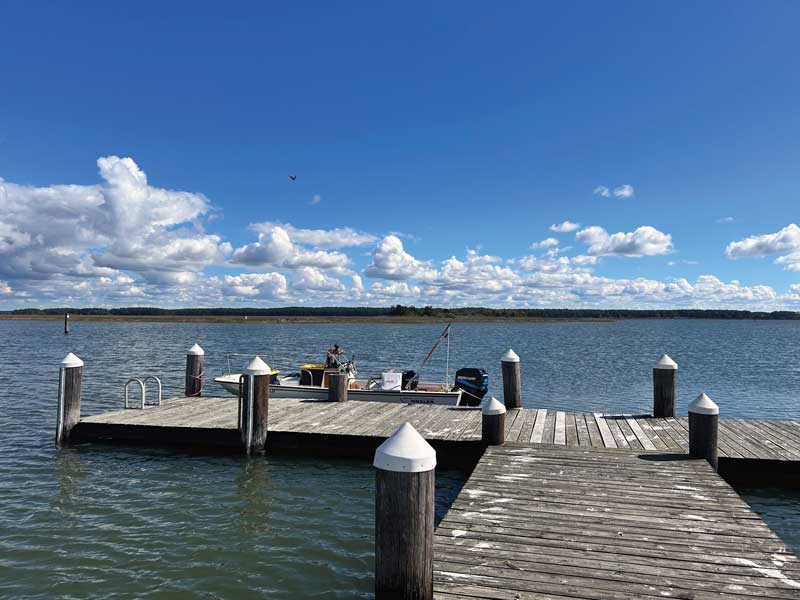
In Solomons I had difficulty finding a place to camp because there’s a military base but also a lot of houses. I had to stay at a hotel that night; there was a Comfort Inn and a marina right next door, and they let me keep my boat there without charging me.
One night while in a very rural area, I was woken up around 1 a.m. and could hear a pig grunting and rooting around my tent. He kept getting closer and closer. I remembered seeing videos of pigs attacking people, so I was a little worried. He was right at my feet and bumping up against my tent. I was able to scare him off, but I was ready in case he came back for revenge. I probably waited for three hours; I didn’t get any sleep that night. Luckily, he never came back.
I had a friend come to do the last leg of the trip with me. He’s an avid boater too. We went to Tangier Island, it was a good experience, and from there we went to Watts Island. It was a really interesting spot. It used to be 400 acres, and it’s dwindled down to just a few. You could see bald eagles nesting there, and watching them hunt was very cool.
One of the most helpful items you brought?
A hard rake. I brought it so I could search the shoreline for arrowheads, but it was very helpful for clearing the campsite.
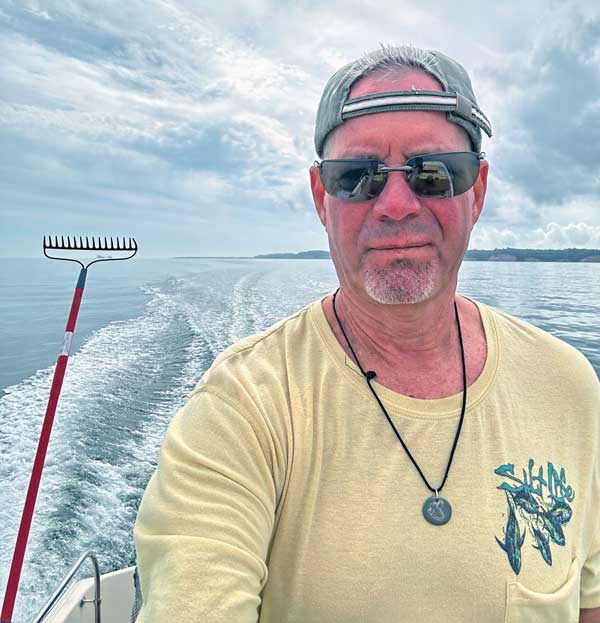
Final thoughts?
There were some days that were just absolutely beautiful. The main reason I did this was because it’s a lifelong dream. If someone else sees this and gets inspired, that’s just awesome, and I would love to share that.
What's pretty cool is that Ernest is not the only one of our readers who has completed an epic journey in his 17-foot Boston Whaler!
- Check out Martin Needle's Whaler Weekends series, where he and his family trailer their Whaler up and down the East Coast.
- And also John W. Robinson's articles: Cruising the DelMarVa Loop, Cruising the Dismal Swamp Canal, and Circumnavigating Manhattan (all in his 17-foot Boston Whaler Montauk).